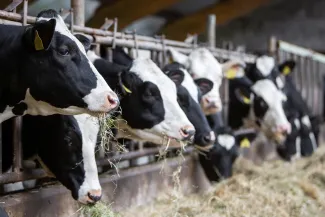
California expert sounds alarm on avian flu’s threat to humans, livestock
© Ruslan Sidorov - iStock-1197330374
Click play to listen to an abbreviated version of this article.
Avian flu, also known as H5N1, continues to infect hundreds of cattle, and is making its way into humans. Since avian flu isn't as easily spread among people for now, the main concern is for those in contact with cows, such as the dairy workers who have reported infections. However, as of November 13, 2024, a teenager in British Columbia -- who seemingly had no contact with animals - is now in critical condition, making it Canada's first human case of bird flu.
Since 2022, the current strain of the virus in the United States has infected over 100 million birds and is remarkable in its "scope and scale" to move beyond its usual avian host, and into mammals at a concerning rate, experts say. Wastewater detection shows the virus present in California, Texas and Michigan, among other states. As of this writing, there have been 53 confirmed human cases in the United States. All, except one, were exposed to infected cattle or birds, according to the CDC. Unlike Canada's critical patient, all U.S. cases reported mild symptoms.
A Potential 'Win-Win' Solution
"No matter how you look at it, we're in a pretty unique and extraordinary position. We've never had an outbreak of an animal-borne virus this large in the last five to 10,000 years of human history since we first domesticated animals for food," Maurice Pitesky, an associate professor and expert in poultry disease modeling at the UC Davis School of Veterinary Medicine, tells Sentient.

© iStock - ktsimage
One of the main reasons for that is how we farm, he says. A California-native, Pitesky has seen hundreds of dairy facilities in the Central Valley alone overlapping or overtaking natural wild bird habitats, such as wetlands. As a result, these wild birds, particularly waterfowl, start congregating near dairy and poultry farms, leading to more interactions with farmed animals, and increasing the risk of avian flu spread.
Pitesky's lab researches how we can shift waterfowl habitat away from livestock farms, for example by restoring wetlands.
"In many ways, that's kind of a win-win solution. It creates a natural habitat for waterfowl - which we've lost a lot of - and then also reduces and mitigates the potential for exposure to viruses," Pitesky says. (It's also good for mitigating climate change.)
Another concern is that avian flu spread to a pig in a backyard farm for the first time in the U.S. this October. Pigs can pick up multiple infections at the same time, which can create a perfect storm in terms of creating a virus that can be easily spread among humans - an example being the swine flu pandemic in 2009.
More needs to be done on the public health side, Pitesky tells Sentient, to avoid human-animal interaction. "An RNA virus [such as avian flu] can mutate really easily. The more that we keep tempting fate by having the virus interact with humans, the greater the potential for the virus to eventually get snake eyes - if you will - as far as how it can adapt to different hosts, including us."
A Resurgence of Raw Milk Could Help the Virus Spread

© ahavelaar - iStock-1501815024
Marjorie Taylor Greene, a controversial far-right politician, recently promoted drinking raw milk on X, citing the Republican movement to "Make America Healthy Again." Robert F. Kennedy Jr., who President-elect Donald Trump has nominated to lead the Department of Health and Human Services, is also a proponent of raw milk. Raw milk can contain a host of other microbes that cause infection and should be avoided to prevent avian flu infection, seeing as a growing number of cattle herds now have the virus. The U.S. Department of Agriculture recently announced they will start testing bulk raw milk for the virus.
The CDC continues to say the current public health risk of avian flu is low, but that hasn't stopped health organizations from gearing up to be prepared. In Canada, several influenza vaccines are "authorized for use," as is a federal manufacturing agreement to scale up vaccine production if there is an avian flu pandemic. In early October, the U.S. invested $72 million in vaccines against avian flu "as part of national preparedness." With the upcoming change in national leadership, however, time will tell if preparing for avian flu remains a priority.
As the virus continues to spread, Pitesky recommends those with backyard chickens or other wild birds use caution when handling birds. For now, anyway, the CDC still advises consumers to avoid raw milk, practice good hygiene and avoid poultry and dairy farms, if possible.
Dawn Attride wrote this article for Sentient.















